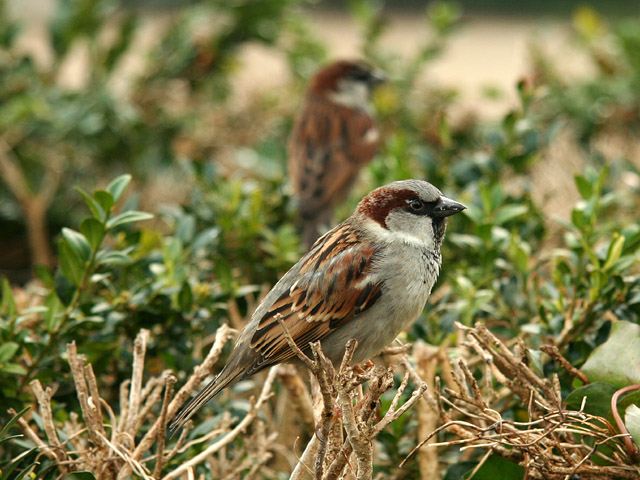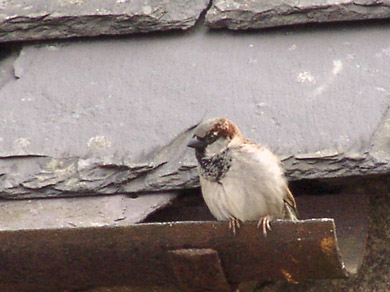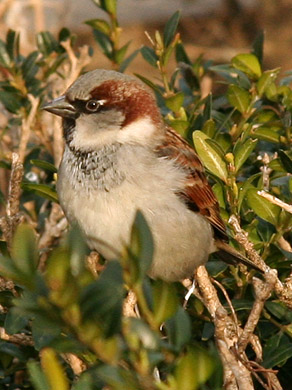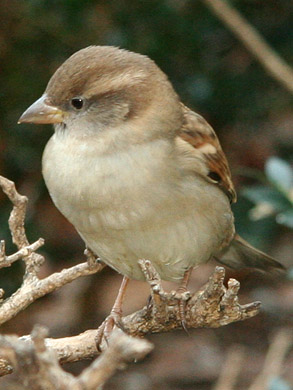"Wherever people build, House Sparrows sooner or later come to share their abodes"


A gutter and a missing roof tile or an eaves-level nestbox
-
all that a sparrow asks for to make a home
House sparrows specialise in grain seeds, but they coped with the disappearance of horses for transport and the massive revolution in agricultural practices of the early 20th century hardly missing a beat. Not so in the last quarter of the 20th century - and paradoxically this decline seems to be peculiar to Western Europe rather than the introduced populations of the New World.
This drop in numbers has caused concern, particularly in London, where the people have long identified with the opportunistic cheer of Passer domesticus celebrated as the 'cockney sparrer' of former times.
Identification - What does it look like?

male house sparrow

Female house sparrow
Unlike the closely related Tree sparrow, male and female House sparrows have different plumage (sexual dimorphism). They sexes are the same size.
The male has a grey crown, bold black bib with white cheeks. The male's bib is most prominent in the breeding season, and his bill changes colour from horn coloured to black. The Female is duller without males head pattern, with a cream eyestripe which is lacking in the male . In both sexes the back is brown and heavily streaked.
What does it sound like?
A disyllabic chirp is a characteristic sound of the house sparrow i nthe breeding season. They have other vocalisations, too.
Read more about the house sparrow at the RSPB
Habitat
Commensal with humans and rarely found very far from human habitation. They prefer to nest in buildings of some sort, though house sparrows will also breed in thick ivy and natural structures. In the UK and most of Europe house sparrows are very sedentary, rarely moving more than a mile from their colony. This behaviour is not universal - in some parts of Asia under some conditions populations of House sparrows are migratory.
Breeding
In the UK the breeding season is from April to August; in the Northern Hemisphere the start varies with latitude - starting in mid-March at 30N and starting May at 60 degrees North. In the UK there are typically three clutches of four eggs over the breeding season, incubated for about 12 days. After hatching the nestlings fledge in approximately two weeks, though they are still dependent on their parents for food. In the Autumn, adults and juveniles typically moved a significant distance to the fields to feed on the grain after harvest time, and this dispersal of the juveniles reduces the risk of inbreeding to the genetic stock.
(ref: The House Sparrow, JD Summers-Smith 1963)
Issues and conservation status
In Northern Europe there has been a steep decline in House sparrows particularly in urban areas. The species is on the UK Red List. Something that is killing living things off in our cities that we do not understand is particularly concerning!
The introduction of the house sparrow to the United States around 1850 was not good for some of the native US birds that occupied the ecological niche that the house sparrow occupied in its native Europe, particularly the Purple Martin and Bluebird.
Relations with People
As its name indicates, the house sparrow has formed a close relationship with human, taking advantage of our buildings for nest sites and our wasteful habits for an easy meal. The relationship is an uneasy one - though in the Old World the sparrow is often looked upon with fondness by modern people it was not always so and the bird is still very wary of us, even though it chooses to live close. In the past the house sparrow has been an agricultural pest, feeding on grain and contaminating grain stores. Though the city has lost the majority of its house sparrows, Londoners did have a particular fondness for the cheeky 'cockney sparrow', identifying with the bird's enterprising and opportunistic nature. Denis Summers-Smith describes how Londoners used to feed flocks of sparrows by hand in the Royal parks in the 1950s and 1960s - nowadays you would be hard pressed to 'twitch' a single sparrow in the Central London parks. Not all Northern European cities have lost their sparrows - Paris has retained its sparrows though even there a decline is observed, but tourists keep the large flock at Notre Dame in good strength. The relationship of the House sparrow with people in the United States appears to be generally hostile - at least from humans, where the sparrow is often resented for its displacement of some charismatic native hole nesting species.